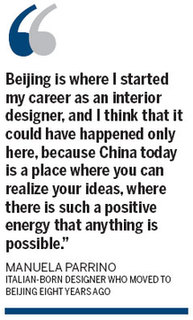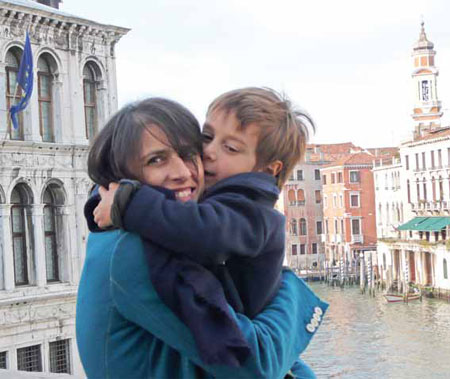Home inspiration
Updated: 2012-06-08 12:40
By Zhang Lei (China Daily)
|
|||||||||||
|
Manuela Parrino with her son Jacopo, in Venice, Italy. "Being a mum is the most important part of my life and Italy is the country where I was born and where my sense of style and design comes from," Parrino says. Provided to China Daily |

Italian interior designer draws on varied experience to tap Chinese market
Manuela Parrino's apartment in downtown Beijing contains a bed from Indonesia, a bookshelf from Jerusalem, blue china and a large work of Chinese calligraphy. The collection might sound like a hotchpotch of color and material, but when viewed as a whole they come together into a harmonious setting. Brave, colorful, independent of trends and a mix of the ethnic and modern - that is exactly how the Italian interior designer defines her work.
Brought up in the historically artistic city of Milan, it is easy to see how Parrino developed her talent for design.
She holds a graduate degree in philosophy of language from the University of Pavia.
Eight years ago, she moved to Beijing where she now works for magazines Vanity Fair, GQ, Io Donna, Gioia, Marie Claire, Conde Nast Traveller, Elle Decor China and AD China.
She has been in art and fashion for many years and has seen a big boom in these areas in China. The economic conditions of Beijing have also helped her change her career path.
"Beijing is where I started my career as an interior designer, and I think that it could have happened only here, because China today is a place where you can realize your ideas, where there's such a positive energy that anything is possible," she says.
"I lived in New York at the beginning of the 1990s and at the time, the United States was where most people called the 'golden land', the land where you could realize your dreams. That land today for me is China."
In 2009, Parrino embarked on two new careers, pushed by friends: interior designer and art gallery owner.
The interior designing began after her houses in Beijing were featured on Elle Decor China and AD China, and the owner of the furniture shop Cottage asked to team up with her to open a new shop in the capital's trendy Sanlitun area. Customers of the shop and readers contacted her to decorate their houses.
The Italian certainly has a lot of experience and training to draw on.
After working for three years as assistant professor at the University of Pavia, in 1995 she enrolled in a one-year master's degree in TV production at the Tisch School of Arts, New York University.
From 1995 to 2001, she worked from New York as a freelance journalist for Italian publications such as Vogue, Marie Claire, Elle, L'Uomo Vogue, D-La Repubblica delle Donne, Io Donna, Carnet and for TV. She also worked as a TV producer on many documentaries for Italian television (RAI) and for Canale 5.
From 2000-01, she worked as editor for the American fashion and design website Inshop.com. At the end of 2001, after traveling and working extensively in the US, she moved to Jerusalem where she continued as a freelancer for Italian publications, producing an award-winning documentary Amira, 26 Hours Trip about a young Palestinian girl leaving Gaza for studies in Germany.
In 2002, she published with her husband (now ex-husband) the book Life at the Time of War - Chronicles from Israel and the Palestinian Territories.
"I also plan to start a blog on a Chinese website to give suggestions and tips about design and style," she says.
Her latest art gallery project started three years ago when an Italian master printer arrived in Beijing to work with famous Chinese artists. Another friend, knowing her love for art and her art collection, offered Parrino a start in this "new adventure".
Her gallery DuoProjects is still a work in progress.
She has helped produce works with leading Chinese artists such as Liu Ye, Zeng Hao, Ji Dachun and Zhang Xiaogang. She also helps represent young artists such as Chen Linggang and is in the process of bringing Indian artists to China.
Immersed in fashion-related works, Parrino also came up with her third job - introducing niche brands to China. The owner of MatModa, which has three stores in New York, is a good friend of hers, and Parrino is currently working on introducing it to her Chinese customers.
"I love all these niche brands, and I love my friend's line. I think it is a pity that they haven't been introduced to China," she says.
Parrino says these three jobs are all different but related to each other. "I am now feeling more like a lifestyle consultant," she says.
How does she cope with the interior design, gallery and fashion brand management work at the same time?
"Actually, my most important job is being a single mother to a 7-year-old boy. For me, that is the best job of all. And I still write, I have a blog in Italy, I'm about to open one in China, and I write about design for Chinese magazines and about Asia for Italian magazines," she says.
Such energy can be attributed to her efficient use of time, she believes.
"I'm very organized. I start working early in the morning as soon as my son gets on the bus to school, then I stop when he comes back from school and continue when he goes to bed," she says.
"Sometime it's not easy and it's tiring. But when you do something that you love, you can do it."
Still, Parrino says there are still big challenges.
First, Beijing is such a huge city and sometimes she spends hours driving from one place to another to look for things, to see customers and to visit artists' studios. In a month, she covers about 2,000 kilometers on the road in the capital.
"Very often, it is a battle to work here but after so many years I have learned how to get things done the way I want. I have also found people that are beautiful to work with because we create an exchange of knowledge. I learn a lot about Chinese furniture, wood, ceramics, restoration, craftsmanship, and they listen and are willing to learn more about style and new ideas."
Second, dealing with suppliers is not easy, because it is hard to find good quality.
"Some people think that because we are in China everything has to be cheap. Wrong. Good quality has a price," she says. "I always give choices to customers - you can have this and it costs this much but the quality is bad; the price can be higher but it's very good quality."
But Parrino says she still likes to work with customers who care about the quality of the product.
All her inspiration comes from her experiences in life. Growing up in Italy, surrounded by beautiful architecture, landscape and objects, is obviously a good start. She also travels a lot and meets "amazing people".
"I'm like a sponge, I absorb everything I see, no matter if it's a beautiful flower or a person walking in the street."
Recently, she was in a cave in the US and she spent an hour looking at the different shapes and colors of rocks inside it. She could not stop thinking that the pattern she was looking at could actually become a beautiful fabric.
"I'm in love with the explosion of colors that you can find in India, the simplicity and edge of Japan, the wood of Indonesia, the style of Italy," she says.
In the beginning, her Chinese customers were worried. They liked her style, but it usually took time for them to overcome the fear of trying something new. But when she got the job done, they were happy and satisfied.
Art, design, fashion and writing - these are Parrino's passions and she has been trying to combine them. So far, the results are pleasing.
"Every day, I come up with new ideas but if you want to do things right, it takes time," she says.
"This is another big challenge in China. People tend to think that if you have an idea for a business, you have to do it fast, and it doesn't matter if the quality of the results is poor. For me, it's the opposite - first the quality. Maybe you'll start the business a month later but you will know that you've done it right."
zhanglei@chinadaily.com.cn
(China Daily 06/08/2012 page29)
Today's Top News
Rescuers race against time for quake victims
Telecom workers restore links
Coal mine blast kills 18 in Jilin
Intl scholarship puts China on the map
More bird flu patients discharged
Gold loses sheen, but still a safe bet
US 'turns blind eye to human rights'
Telecom workers restore links
Hot Topics
Lunar probe , China growth forecasts, Emission rules get tougher, China seen through 'colored lens', International board,
Editor's Picks

|

|

|

|

|

|






